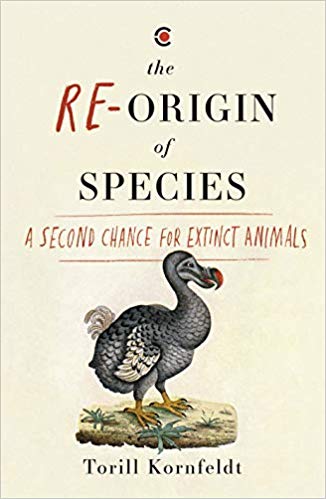Reading Torill Kornfeldt’s book The Re-Origin of Species: A Second Chance for Extinct Animals feels a little odd. Part of that is to do with its translatedness. Make no mistake about it; Fiona Graham has done an excellent job, barring an occasional infelicity such as nanny goats ‘falling pregnant’ (and there are quite a few avoidable errors of copy editing). And I am still trying to work my tongue around Stewart Brand’s drawl adding an ‘sh’ sound to every ‘w’. No matter. I am, however, reminded of Spanish-speaking friends who used to say that Gabriel Garcia Marquez sounded quite different in his own voice in Spanish from either Grossman’s or Rambassa’s voices in English (and Kornfeldt’s descriptions of the biotechnology involved can feel pretty much like magic realism, too). I keep wondering how Kornfeldt’s book sounded both in Swedish and in 2016 (when it was published). That two-year gap creates an additional odd sense of datedness in a field where things were changing, as Kornfeldt points out, even as she was writing. In fact, the deeply personal voice and immediacy with which Kornfeldt apparently writes enhances this nagging, permeating sense of, not worry exactly, but a subliminal anxiety, about ‘is that what she meant?’ and ‘is that when she meant it?’
The central conceit that the book takes on, the ‘re-creation’ of extinct species using a range of biotechnological methods is imbued, of course, with the same oddly dislocating idea of translatedness. As Kornfeldt repeatedly points out, many of these efforts at ‘re-creation’ will end up creating, ‘a new species, not replicas of an ancient one’. No wonder I keep wondering how much of her book, too, is a new book, and not a replica of a 2016 Swedish book.
Kornfeldt, even in her introduction, makes it clear just how limited her perspective of ‘science’ is. She is worth quoting on this: ‘Each day as a science journalist brings me examples of how scientific curiosity and zeal are improving life for almost all human beings. These range from the technology we use to the medicines we take, the food we eat and the clothes we wear.’ There is a lot to unpack there. In the first place, not to see that medicines, food and clothes are, in fact, all ‘technologies’ is to miss the core meaning of ‘technologies’. More importantly, it is evident that for Kornfeldt, the basic connection between (natural) science and society is through the development of technologies. While it is not incorrect, such a perspective is deeply limited and does enormous disservice to the potential of the (natural and social) sciences for democratic empowerment, understanding the nuance of cause-and-effect in the world we live in. One (if not the) crucial question in all these sciences is one that Kornfeldt never asks: ‘How does/did this work?’ It is remarkable that she sees the ‘zeal’, the ‘boundless enthusiasm’, and the ‘curiosity’ of the scientists she meets, and yet never quite seems to see that (among many other things) they are looking for ‘mechanisms’ and new ways of discovering them.

